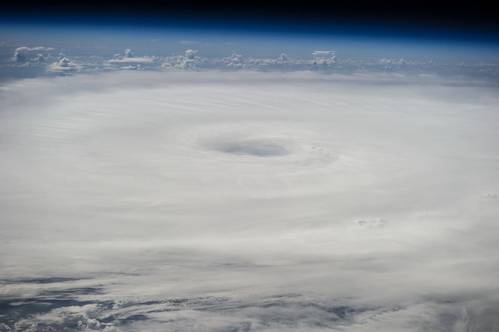Why Do Some Hurricanes Rapidly Intensify?

Photograph of Hurricane Edouard taken from the International Space Station on September 17, 2014. (Credit: NASA JSC/ISS)
Why do some hurricanes rapidly intensify while others don’t? A recent study modeled a 2014 hurricane to find out.
To understand what fuels the rapid intensification of hurricanes, researchers from NOAA and the Cooperative Institute for Marine and Atmospheric Studies (CIMAS) based at the University of Miami (UM) Rosenstiel School of Marine and Atmospheric Science used the Hurricane Weather Research and Forecast (HWRF) model, a predictive hurricane model that lets them use different measurements to run diverse storm scenarios, known as an ensemble, to get an idea of the different forecasts that are possible from a particular storm.
In this study, forecasts from an HWRF ensemble of Hurricane Edouard in 2014 were analyzed to understand the differences between hurricanes that intensify rapidly and those that do not.
Rapid intensification is defined as an increase in the maximum sustained winds of at least 35 miles per hour (55 km/h) in a 24-hour period, to better predict the storm’s ultimate intensity when it reaches landfall.
The study describes a power struggle between thunderstorm activity and environmental flow in the upper levels of the atmosphere. The study showed when persistent thunderstorms in a specific region of the storm overcome the winds in the upper levels and wrap around the storm center, the storm rapidly intensifies. In storms that don’t intensify, the thunderstorms continued to develop but never overcame the prevailing flow. The winner of this battle between the thunderstorms and the upper-level environmental flow can predict whether a storm will rapidly intensify or not. When the upper-level environmental flow in the specific location is in the opposite direction of the hurricane’s rotation, it tends to inhibit the wrapping around of thunderstorms and prevent the storm from undergoing rapid intensification.
“This study could help hurricane forecasting by looking at the hurricane environment in a different way to improve forecasts,” said Hua Leighton, a researcher at NOAA’s Atlantic Oceanographic and Meteorological Laboratory and lead author of the study.
The study, titled “Azimuthal Distribution of Deep Convection, Environmental Factors, and Tropical Cyclone Rapid Intensification: A Perspective from HWRF Ensemble Forecasts of Hurricane Edouard (2014),” was published in the January 2018 issue of the Journal of the Atmospheric Sciences. The study’s authors include: Hua Leighton; Sundararaman Gopalakrishnan; Jun A. Zhang and Robert F. Rogers from NOAA’s Atlantic Oceanographic and Meteorological Laboratory; Zhan Zhang and Vijay Tallapragada from NOAA’s Environmental Modeling Center in College Park, Maryland.














 December 2025
December 2025



